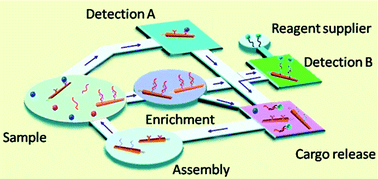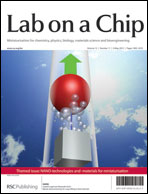Cargo-towing synthetic nanomachines: Towards active transport in microchip devices†
Abstract
This review article discusses the use of synthetic catalytic nano motors for cargo manipulations and for developing miniaturized lab-on-chip systems based on autonomous transport. The ability of using chemically-powered artificial nanomotors to capture, transport and release therapeutic payloads or nanostructured biomaterials represents one of the next major prospects for nanomotor development. The increased cargo-towing force of such self-propelled nanomotors, along with their precise motion control within microchannel networks, versatility and facile functionalization, pave the way to new integrated functional lab-on-a-chip powered by active transport and perform a series of tasks. Such use of cargo-towing artificial nanomotors has been inspired by on-chip kinesin molecular shuttles. Functionalized nano/microscale motors can thus be used to pick a selected nano/microscale chemical or biological payload target at the right place, transport and deliver them to a target location in a timely manner. Key challenges for using synthetic nanomachines for driving transport processes along microchannel networks are discussed, including loading and unloading of cargo and precise motion control, along with recent examples of related cargo manipulation processes and guided transport in lab-on-a-chip formats. The exciting research area of cargo-carrying catalytic man-made nanomachines is expected to grow rapidly, to lead to new lab-on-a-chip formats and to provide a wide range of future microchip opportunities.

- This article is part of the themed collection: NANO-technologies & -materials for miniaturisation

 Please wait while we load your content...
Please wait while we load your content...